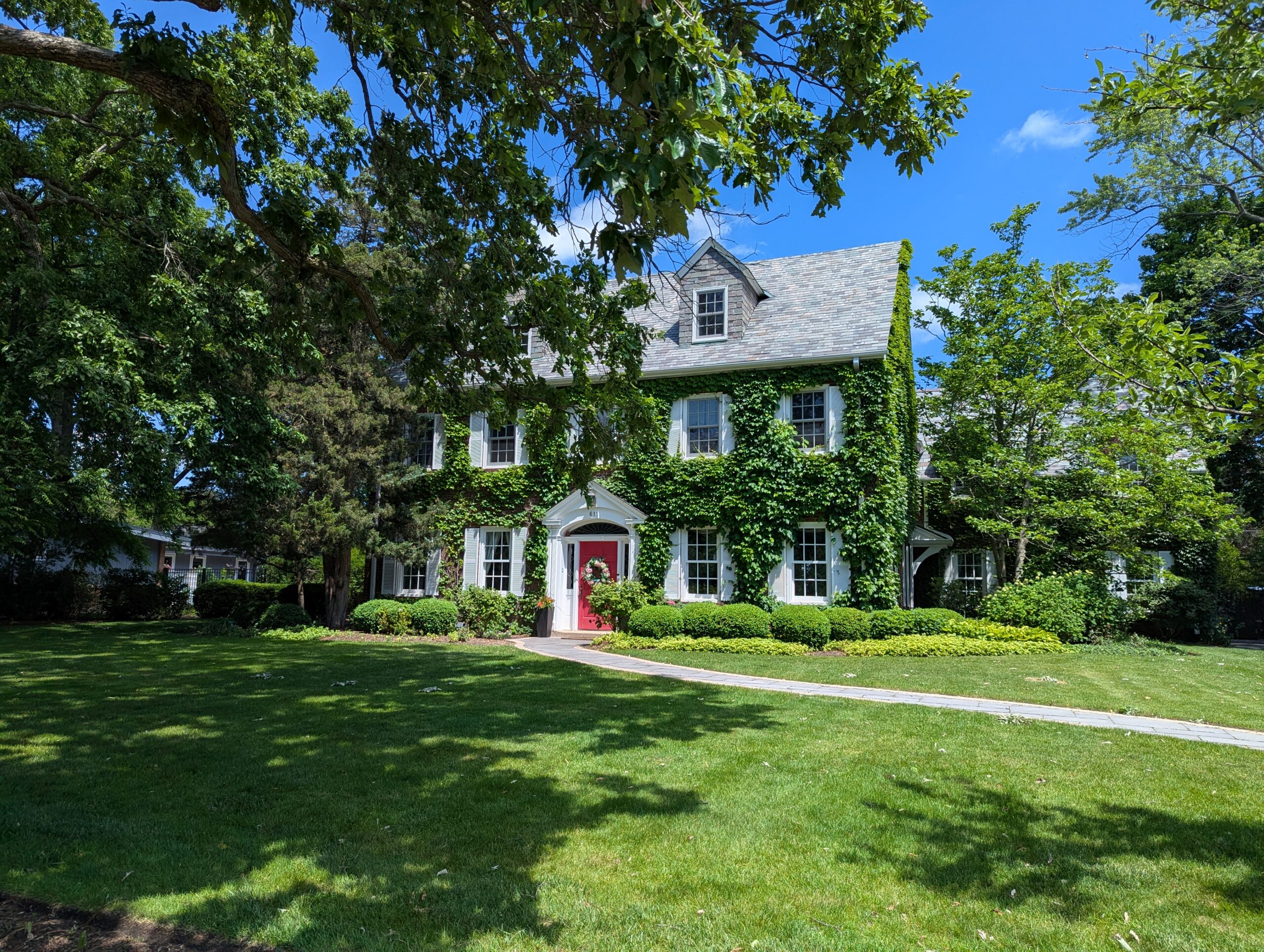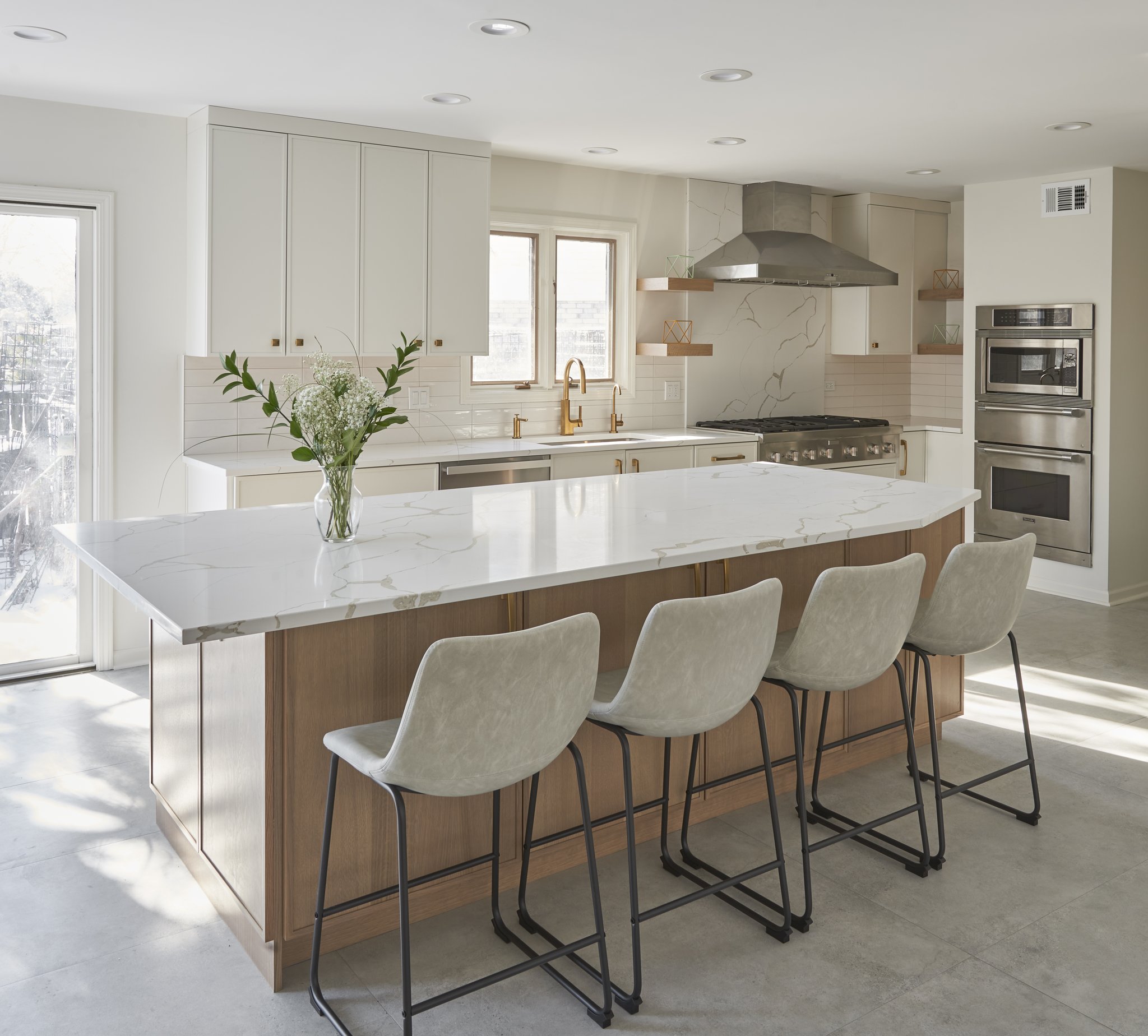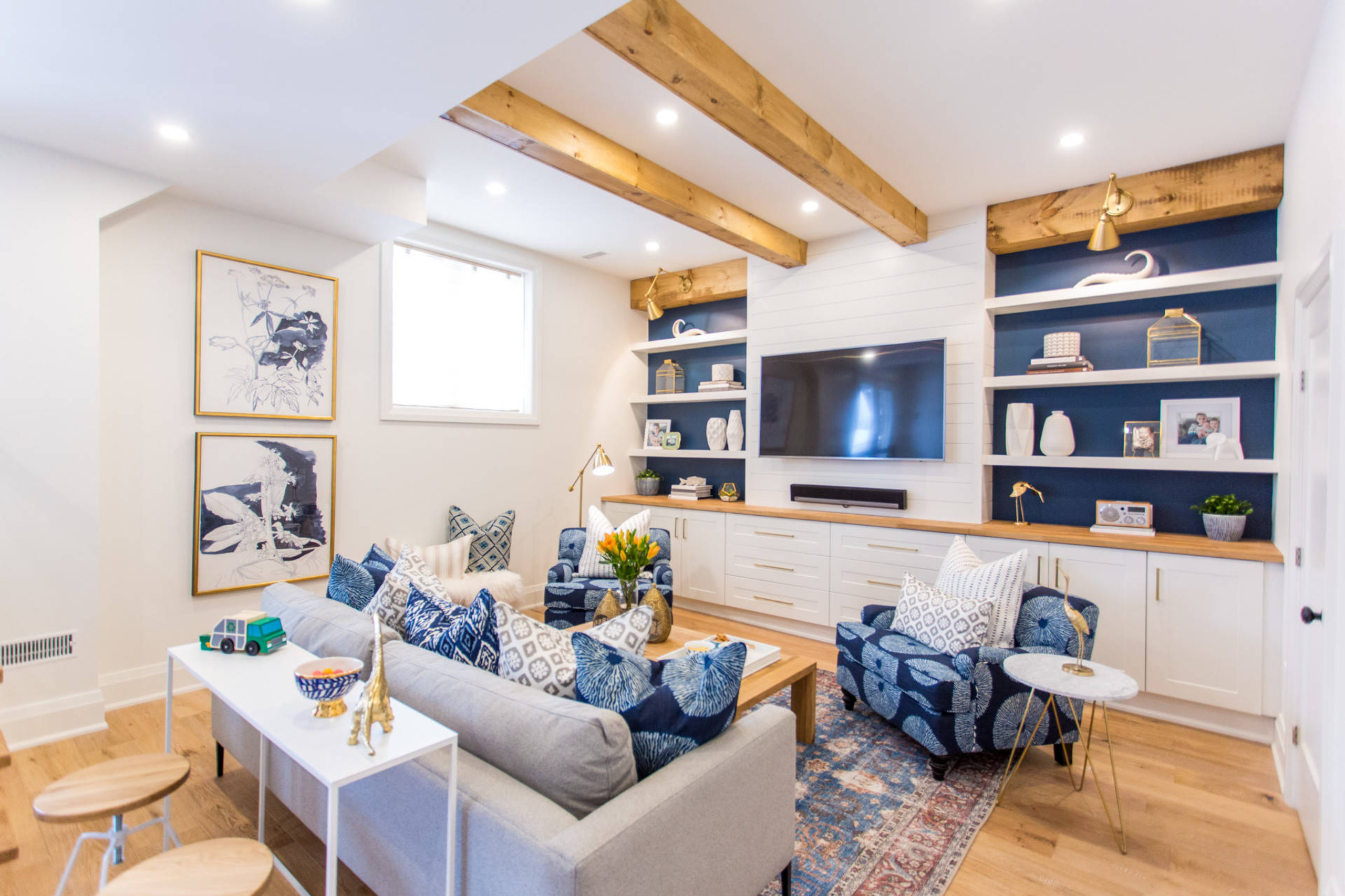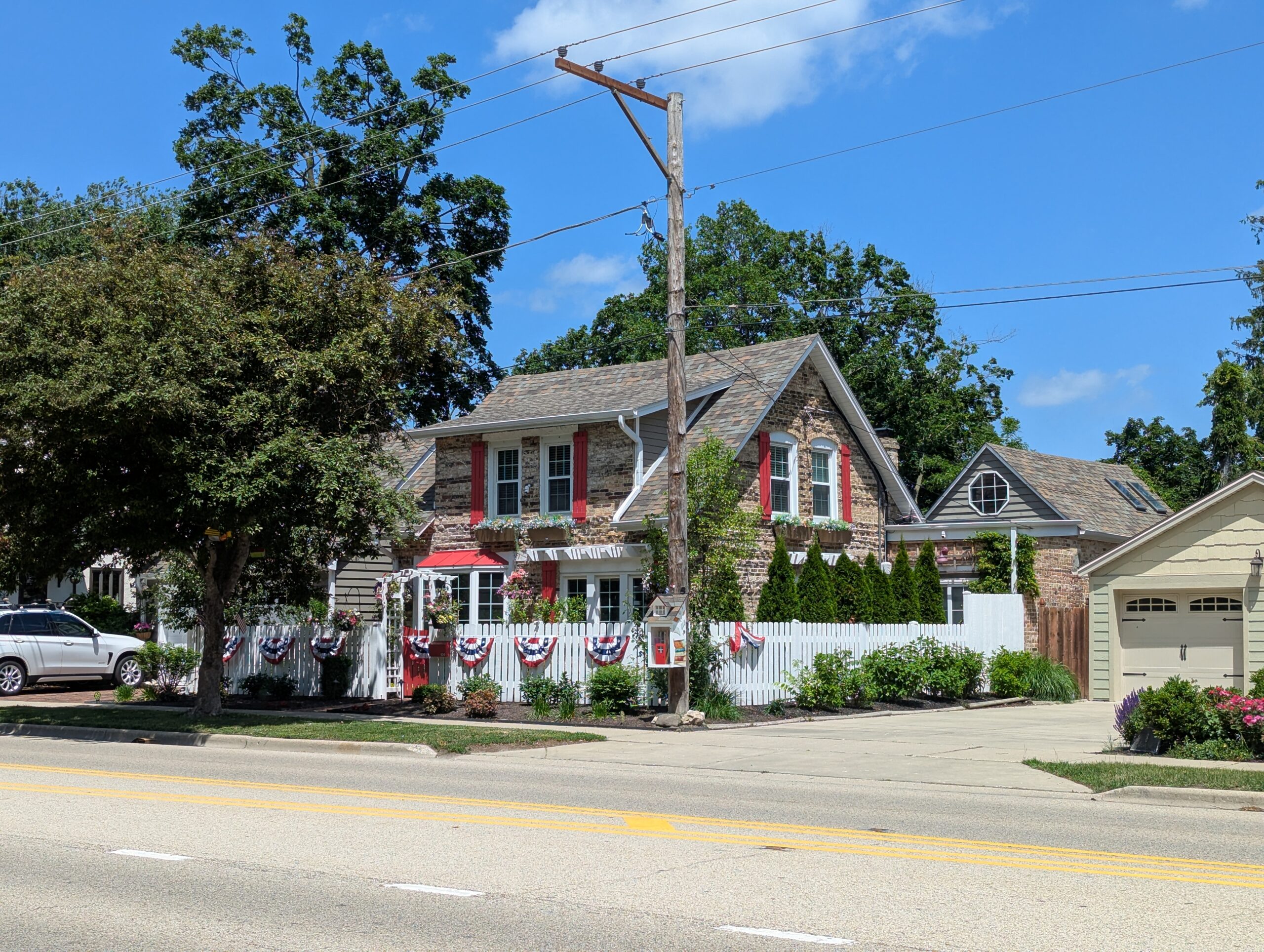The North Shore’s tree-lined streets are graced with some of Chicago’s most architecturally significant homes — stately Tudors, elegant Georgians, and charming Colonials that have stood for decades, even centuries. These historic residences in communities like Winnetka, Lake Forest, and Glencoe offer unparalleled character, craftsmanship, and established neighborhoods that new construction simply cannot replicate. Yet, while the architectural bones of these homes remain exceptional, their floor plans and systems were designed for a different era — one with smaller families, live-in help, and vastly different lifestyle expectations.
Today’s families need open, flowing spaces that accommodate how we actually live: cooking while entertaining, juggling remote work with household activities, and creating multifunctional areas that serve changing needs throughout the day. The challenge — and opportunity — lies in thoughtfully updating these distinguished homes to meet contemporary demands while preserving the architectural integrity and charm that make them so desirable in the first place. When approached with respect for both history and functionality, older North Shore homes can be transformed into spaces that beautifully serve modern family life without sacrificing their timeless appeal.
The Unique Challenges of Older North Shore Homes
Homes built before the 1960s present distinctive challenges that require thoughtful planning and expertise. According to the National Trust for Historic Preservation, nearly 40% of America’s housing stock was built before 1970, and these homes often share similar structural and functional limitations that homeowners must navigate during renovation.

Architectural and Structural Considerations
The compartmentalized floor plans typical of pre-war homes reflect a formal lifestyle where each room served a single, specific purpose. Kitchens were designed as working spaces, often relegated to the back of the house with separate butler’s pantries and small service areas. Dining rooms stood in isolation, and living spaces were divided into multiple small parlors and sitting rooms. While this formality created beautiful architectural details — pocket doors, crown molding, detailed millwork — it creates challenges for families who want the casual, connected living spaces that define contemporary life.
Load-bearing walls present another significant hurdle. Unlike modern construction with engineered systems, older homes often rely on interior walls to support the structure above. Removing or relocating these walls requires sophisticated structural engineering, steel beam installation, and careful execution to maintain the home’s integrity. Plaster walls, while more substantial than drywall, can be delicate to work with and may reveal underlying issues once renovation begins.
Outdated Systems and Infrastructure
Perhaps the most significant invisible challenges lie behind the walls. Electrical systems in homes from the 1920s through 1950s were designed for a fraction of today’s power demands. According to the National Fire Protection Association, homes with outdated electrical systems face increased fire risks and simply cannot support the demands of modern appliances, lighting, and technology without complete rewiring.
Plumbing presents similar concerns. Galvanized steel pipes, common in homes built before 1960, corrode over time, reducing water pressure and quality. Cast iron drain systems can fail, and the small-diameter supply lines cannot deliver the water volume required by contemporary fixtures and appliances. Many older North Shore homes also lack adequate bathroom facilities — often featuring just one full bathroom for an entire second floor of bedrooms, a configuration that simply doesn’t work for today’s families.
Heating systems in historic homes were often designed around radiators and boiler systems, which, while charming, limit options for central air conditioning. The lack of ductwork means adding climate control requires creative solutions that work within existing structural constraints.
Expert Tip: Before purchasing or beginning renovation of an older North Shore home, invest in comprehensive inspections that go beyond standard home inspection protocols. Engage specialists in electrical, plumbing, and structural engineering to understand the full scope of systems that may need updating. This due diligence prevents costly surprises and allows for accurate project planning and budgeting.
Transforming the Kitchen: More than a Cooking Station
The kitchen remodeling project represents the most transformative opportunity in updating an older North Shore home. Vintage kitchens — often measuring just 10×12 feet with minimal counter space, inadequate storage, and appliances from another era — must evolve into the command centers modern families require.

Creating Open, Connected Spaces
The most impactful strategy involves removing walls between the kitchen, dining room, and adjacent spaces to create the open floor plan that defines contemporary living. This typically requires structural engineering to install support beams that redistribute loads previously carried by interior walls. In a recent Highland Park remodeling project, removing the wall between a cramped 1920s kitchen and formal dining room created a 450-square-foot great room that maintains period-appropriate details while functioning for modern entertaining.
When full wall removal isn’t feasible — or when homeowners want to preserve some definition between spaces — consider creating generous pass-throughs or cased openings. These maintain visual connection while preserving structural integrity and allowing each space to retain some identity. Wide openings framed with period-appropriate trim can honor the home’s architectural heritage while improving functionality.
Expanding Footprint and Optimizing Layout
Many North Shore kitchen renovations benefit from expansion into adjacent spaces. Butler’s pantries, breakfast rooms, mudrooms, or even enclosed porches can be incorporated to create the square footage needed for today’s kitchens. According to Houzz research on kitchen trends, the average remodeled kitchen now measures between 200-300 square feet, allowing for multiple work zones and comfortable circulation.
The layout should embrace the work triangle concept while accommodating multiple cooks. In larger kitchens, islands provide essential additional workspace, storage, and casual seating — a feature completely absent from vintage designs. Position the island to maintain clear circulation paths while creating natural zones for preparation, cooking, and cleanup.
Preserving Character While Adding Function
The most successful vintage kitchen renovations balance modern function with period-appropriate aesthetics. Bertch Cabinets offers custom cabinetry lines that can be specified to match historic profiles while incorporating modern storage innovations like soft-close mechanisms, pull-out organizers, and specialty storage solutions.
Consider a mix of glass-front upper cabinets reminiscent of old pantry storage, combined with deep drawers and pull-out systems in base cabinets. This provides both the visual reference to the home’s era and the practical storage modern kitchens demand. For hardware, companies like Rejuvenation specialize in historically accurate pulls, knobs, and fixtures that complement vintage architecture.
Flooring choices should consider both durability and authenticity. Wide-plank oak flooring, properly finished and sealed, provides timeless beauty. Alternatively, high-quality porcelain tile from Porcelanosa can replicate the look of historic materials like marble or terrazzo while offering superior durability and easier maintenance.
Appliances and Fixtures for Contemporary Performance
Modern appliances represent one area where functionality must take precedence, but thoughtful selection minimizes visual disruption. Panel-ready refrigerators that accept cabinet fronts maintain a cohesive appearance. Kohler produces farmhouse sinks in both traditional apron-front configurations and modern undermount styles that bridge historic and contemporary aesthetics.
For cooking, professional-grade ranges provide the power and versatility today’s cooks expect while maintaining a commanding presence appropriate to substantial older homes. Ventilation is critical — older homes lack proper kitchen exhaust systems, so plan for substantial range hoods that can be integrated into the cabinetry design or made into architectural features themselves.
Bathroom Updates: From Functional Necessity to Personal Retreat
Bathroom remodeling in older North Shore homes addresses both quantity and quality concerns. Families accustomed to contemporary standards need both additional bathrooms and spa-quality updates to existing spaces.

Adding Necessary Bathrooms
The most common challenge in vintage homes is insufficient bathroom count. A four-bedroom home with only one-and-a-half baths creates daily congestion and limits functionality. Strategic bathroom additions typically involve carving space from oversized bedrooms, closets, or hallways. In homes with generous room proportions — common in North Shore estates — a 12×15-foot bedroom can be reconfigured into a 10×12-foot bedroom with a 5×8-foot ensuite bathroom without significantly compromising either space.
Second-floor hallway bathrooms can sometimes be expanded into adjacent closet space or underutilized areas. Careful planning ensures that new plumbing stacks align efficiently with existing systems, minimizing structural impact and cost. Locating new bathrooms above or adjacent to existing plumbing reduces the complexity of routing supply and drain lines.
Transforming Primary Bathrooms
Primary bathroom renovations in older homes often involve combining two smaller spaces — perhaps a modest bathroom with an adjacent bedroom, dressing room, or sleeping porch — to create the generous, spa-like suites modern homeowners expect. A properly designed primary bathroom should include a spacious shower, separate soaking tub, dual vanities, ample storage, and possibly a water closet for privacy.
Material selection should complement the home’s architecture while providing the durability and ease of maintenance contemporary life demands. Large-format porcelain tiles from MSI offer the look of natural stone like Carrara or Calacatta marble with superior performance characteristics. For classic appeal, consider subway tile in traditional 3×6-inch format with contrasting grout — a historically appropriate choice that remains timelessly elegant.
Fixtures deserve particular attention. Waterworks produces collections that reference historic periods while incorporating modern valve technology and water delivery systems. Cross-handle faucets and exposed-pipe shower systems can evoke vintage charm while providing contemporary performance. For a seamless glass shower enclosure that feels more modern, specify minimal hardware and frameless panels that don’t compete with period details elsewhere in the space.
Upgrading Secondary and Powder Bathrooms
Secondary bathrooms in older homes often suffer from outdated fixtures, insufficient storage, and cramped layouts. Even without major square footage additions, thoughtful updates can dramatically improve functionality. Replacing a pedestal sink with a floating vanity immediately adds storage without reducing floor space. Installing a modern toilet with efficient flushing and comfortable height improves daily use.
Powder rooms present opportunities for bold design choices. These small spaces can accommodate dramatic wallcoverings, statement lighting from Rejuvenation, and distinctive fixtures that might overwhelm larger spaces. A vintage-style wall-mounted sink with exposed brass trap, paired with period-appropriate sconces and a framed mirror, creates jewel-box moments that honor the home’s heritage.
Expert Tip: When adding or expanding bathrooms in older homes, work with experienced contractors familiar with historic construction. Unexpected discoveries — from hidden chimneys to unusual framing — are common, and adapting plans in real-time requires both technical expertise and creative problem-solving. Allow contingency in both budget and timeline for these inevitable surprises.
Basement Transformations: Unlocking Valuable Living Space
The basement remodeling opportunity in older North Shore homes is substantial but requires addressing challenges unique to vintage construction. Many pre-1960s basements feature low ceilings, stone or brick foundations, moisture concerns, and minimal natural light — factors that historically relegated these spaces to storage and mechanicals.

Addressing Structural and Environmental Issues
Before any finish work begins, address fundamental moisture and structural concerns. Older basements with stone foundations may experience water infiltration that requires professional waterproofing solutions. French drains, exterior excavation and waterproofing, and interior drainage systems ensure the space remains dry and healthy for finished living areas.
Ceiling height presents another common challenge. Many vintage basements offer only 6’6″ to 7′ of clearance, which feels cramped for living spaces. For homes with adequate foundation depth, underpinning — excavating to lower the basement floor — can add precious height. This complex structural undertaking requires engineering and permits but can transform an unusable basement into valuable living space.
Alternatively, work with existing ceiling heights by minimizing ductwork and mechanical systems’ intrusion. Spray foam insulation applied to the underside of floor joists creates a clean, uniform surface while insulating and providing a higher finished ceiling than traditional framing methods. Recessed lighting eliminates the need for fixtures that extend down into the space.
Creating Functional Family Zones
Modern families use basements for diverse purposes: media rooms, home gyms, playrooms, home offices, guest suites, and recreation areas. The key to successful basement renovations lies in creating defined zones that serve these varied functions without rigid compartmentalization.
An open plan with distinct areas works well. Position a media viewing area at one end, defined by furniture arrangement and lighting rather than walls. A play zone or home gym occupies another area, with durable flooring appropriate to its use. If ceiling height and egress windows permit, a guest bedroom and full bathroom can be incorporated, adding valuable flexibility for visiting family or older children seeking independence.
Natural light dramatically improves basement livability. Enlarging existing window wells, adding new egress windows, or creating English-style walkouts (where possible) bring daylight into previously dark spaces. When windows are limited, supplement with thoughtful artificial lighting. Layer recessed ambient lighting with task lighting and accent fixtures to create warmth and visual interest. Lightology offers extensive selections of recessed and track lighting systems ideal for basement applications.
Finishes and Details That Elevate the Space
Material selection should acknowledge the basement’s unique environment while creating comfortable, attractive spaces. Luxury vinyl plank (LVP) flooring provides the appearance of hardwood with superior moisture resistance. For areas that might experience dampness, porcelain tile offers unlimited design possibilities with complete imperviousness to water.
Wall finishes require moisture-resistant materials. Cement board or fiberglass-faced drywall provides appropriate substrates for paint or tile. If exposing original stone or brick foundations, seal them properly with masonry sealers that allow vapor transmission while preventing moisture penetration and efflorescence.
Built-in storage takes advantage of awkward spaces around mechanicals, under stairs, and in lower-ceiling areas. Custom cabinetry from Solid Cabinetry can maximize these challenging zones while maintaining the finished, intentional appearance that defines quality remodeling.
Maintaining Mechanical Access
Basements house critical home systems — furnaces, water heaters, electrical panels, and increasingly, modern utilities like network equipment and water treatment systems. Design must accommodate both access for service and visual integration. Mechanical rooms can be separated with pocket doors that disappear when open, or equipment can be enclosed in cabinets with removable panels. Ensure mechanical areas include adequate clearances for service and future equipment replacement.
Preserving What Makes These Homes Special
The most successful adaptations of older North Shore homes achieve a delicate balance: thoroughly updating for contemporary function while preserving the architectural character and craftsmanship that make these houses irreplaceable. This means celebrating rather than concealing period details — keeping original moldings, protecting hardwood floors, restoring rather than replacing vintage windows when possible, and ensuring new elements complement rather than compete with historic features.

Work with contractors, such as 123 Remodeling, experienced in historic renovation who understand both period architecture and modern building science. The intersection of old and new requires specialized knowledge — how to tie into existing structure, work around unknowns that emerge during demolition, and integrate contemporary systems into vintage frameworks. A design-build approach often works particularly well for these complex projects, ensuring design and construction expertise work in concert from initial concept through completion.
According to the National Association of Realtors, homes in established neighborhoods with mature landscaping and architectural distinction consistently hold value better than new construction in developing areas. The investment in thoughtfully updating an older North Shore home not only improves quality of life but protects and enhances one of your most significant financial assets.
The older homes gracing North Shore communities represent more than just shelter — they’re architectural achievements with stories to tell and craftsmanship that modern construction rarely replicates. Yet they must also serve as comfortable, functional homes for today’s families with contemporary needs and lifestyles. The good news is that these goals aren’t mutually exclusive. With thoughtful planning, experienced execution, and respect for both heritage and function, these distinguished homes can be transformed to serve modern life beautifully while retaining everything that makes them special.
Whether you’re considering a comprehensive whole-home renovation or focused updates to key spaces like kitchens and bathrooms, the journey begins with understanding both your home’s unique characteristics and your family’s specific needs. The team at 123 Remodeling brings extensive experience adapting older North Shore homes in communities from Glencoe to Lake Forest, Northbrook to Evanston. We understand the distinctive challenges these homes present and the opportunities they offer.
Ready to explore how your older North Shore home can be transformed to serve your family’s modern lifestyle while preserving its timeless character? Contact 123 Remodeling at (773) 685-6095 or use our contact form to schedule a consultation. Let’s discuss how we can honor your home’s past while creating its future.



